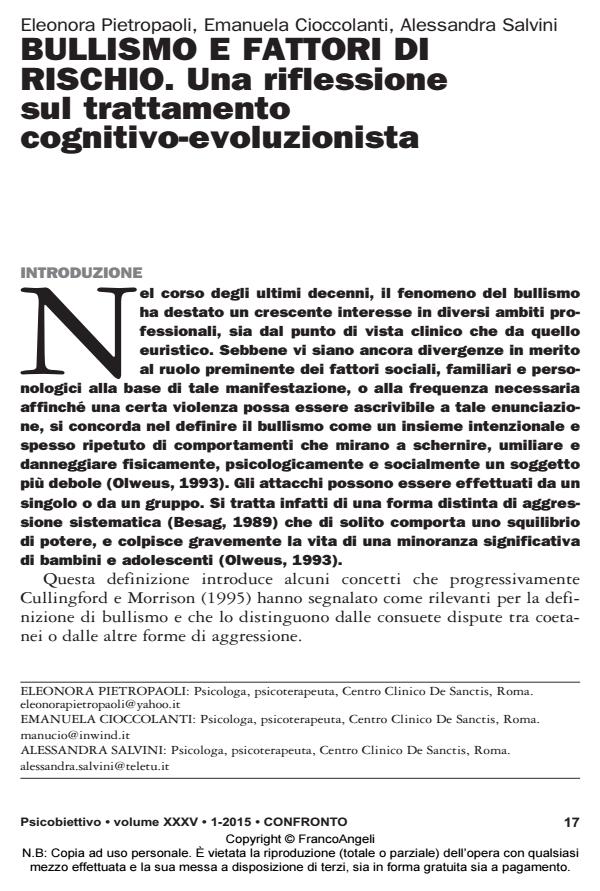Bullismo e fattori di rischio. Una riflessione sul trattamento cognitivo-evoluzionista
Titolo Rivista PSICOBIETTIVO
Autori/Curatori Eleonora Pietropaoli, Emanuela Cioccolanti, Alessandra Salvini
Anno di pubblicazione 2015 Fascicolo 2015/1
Lingua Italiano Numero pagine 18 P. 17-34 Dimensione file 123 KB
DOI 10.3280/PSOB2015-001002
Il DOI è il codice a barre della proprietà intellettuale: per saperne di più
clicca qui
Qui sotto puoi vedere in anteprima la prima pagina di questo articolo.
Se questo articolo ti interessa, lo puoi acquistare (e scaricare in formato pdf) seguendo le facili indicazioni per acquistare il download credit. Acquista Download Credits per scaricare questo Articolo in formato PDF

FrancoAngeli è membro della Publishers International Linking Association, Inc (PILA)associazione indipendente e non profit per facilitare (attraverso i servizi tecnologici implementati da CrossRef.org) l’accesso degli studiosi ai contenuti digitali nelle pubblicazioni professionali e scientifiche
In questo lavoro gli autori espongono una breve rassegna delle diverse forme e modalità con cui viene esercitato il bullismo, ponendo attenzione ai fattori di rischio quali: lo stile temperamentale e personologico indi viduale, la tipologia familiare e la qualità delle prime relazioni di attaccamento. Dopo aver passato in rassegna le metodiche di tipo preventivo utilizzate in ambito scolastico e comunitario per arginare il fenomeno del bullismo, si è passati ad una riflessione di interesse clinico rispetto alla possibilità di sperimentare interventi di trattamento mirati al miglioramento delle rappresentazioni mentali delle relazioni di attaccamento e alla stabilizzazione della sintomatologia che deriva dagli atti bullistici. L’approccio cognitivo-evoluzionista per una revisione dei modelli operativi interni e il trattamento EMDR nella cura dell’aspetto traumatico dell’esperienza sono ormai in letteratura considerati metodi evidence-based. Tali interventi vengono proposti in associazione e continuità a quelli di prevenzione già attuati nelle scuole.
Parole chiave:Bullismo; fattori di rischio; stile di attaccamento; terapia cognitivo-evoluzionista; trauma; terapia EMDR.
Eleonora Pietropaoli, Emanuela Cioccolanti, Alessandra Salvini, Bullismo e fattori di rischio. Una riflessione sul trattamento cognitivo-evoluzionista in "PSICOBIETTIVO" 1/2015, pp 17-34, DOI: 10.3280/PSOB2015-001002